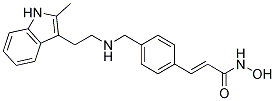All AbMole products are for research use only, cannot be used for human consumption.

LBH589 (Panobinostat, NVP-LBH589) is a novel deacetylase inhibitor and has been shown to induce acetylation of histone H3 and H4, increase p21 levels, disrupt the chaperone function of hsp90, and induce cell-cycle G1 phase accumulation and apoptosis of K562 cells and acute leukemia MV4-11 cells. LBH589 (Panobinostat, NVP-LBH589) has also recently been found to significantly increase in vitro the survival of motor neuron (SMN) protein levels in cells of patients suffering from spinal muscular atrophy.

Biochem Pharmacol. 2024 Feb 17;116065.
Panobinostat sensitizes AraC-resistant AML cells to the combination of azacitidine and venetoclax
LBH589 (Panobinostat) purchased from AbMole

J Biol Chem. 2022 Sep;298(9):102314.
Induction of zinc finger protein RNF6 auto-ubiquitination for the treatment of myeloma and chronic myeloid leukemia
LBH589 (Panobinostat) purchased from AbMole

BMC Biol. 2021 May 20;19(1):108.
Very long intergenic non-coding (vlinc) RNAs directly regulate multiple genes in cis and trans
LBH589 (Panobinostat) purchased from AbMole
| Molecular Weight | 349.43 |
| Formula | C21H23N3O2 |
| CAS Number | 404950-80-7 |
| Solubility (25°C) | DMSO 59 mg/mL |
| Storage |
Powder -20°C 3 years ; 4°C 2 years In solvent -80°C 6 months ; -20°C 1 month |
| Related HDAC Products |
|---|
| CM-444
CM-444 is an inhibitor for HDAC and DNA methyltransferases (DNMT) with IC50 values of 6 nM-0.6 μM and 1.8-2.3 μM, respectively. CM-444 is an inducer for the differentiation of acute myeloid leukemia cells. CM-444 exhibits anti-leukemic activity and improves the survival rate in mouse models. |
| CM-1758
CM-1758 is a histone deacetylase (HDAC) inhibitor. CM-1758 inhibits tumor growth in vivo. CM-1758 induces acetylation of non-histone proteins in acute myeloid leukemia cells. |
| T-518
T-518 is an orally active, selective, and blood-brain barrier permeable HDAC6 inhibitor with an IC50 value of 36 nM for human HDAC6. |
| SE-7552
SE-7552, a 2-(difluoromethyl)-1,3,4-oxadiazole (DFMO) derivative, is an orally active, highly selective, non-hydroxamate HDAC6 inhibitor with an IC50 of 33 nM. |
| BRD9757
BRD9757 is a potent, capless and selective HDAC6 inhibitor with an IC50 of 30 nM. |
All AbMole products are for research use only, cannot be used for human consumption or veterinary use. We do not provide products or services to individuals. Please comply with the intended use and do not use AbMole products for any other purpose.


Products are for research use only. Not for human use. We do not sell to patients.
© Copyright 2010-2024 AbMole BioScience. All Rights Reserved.
